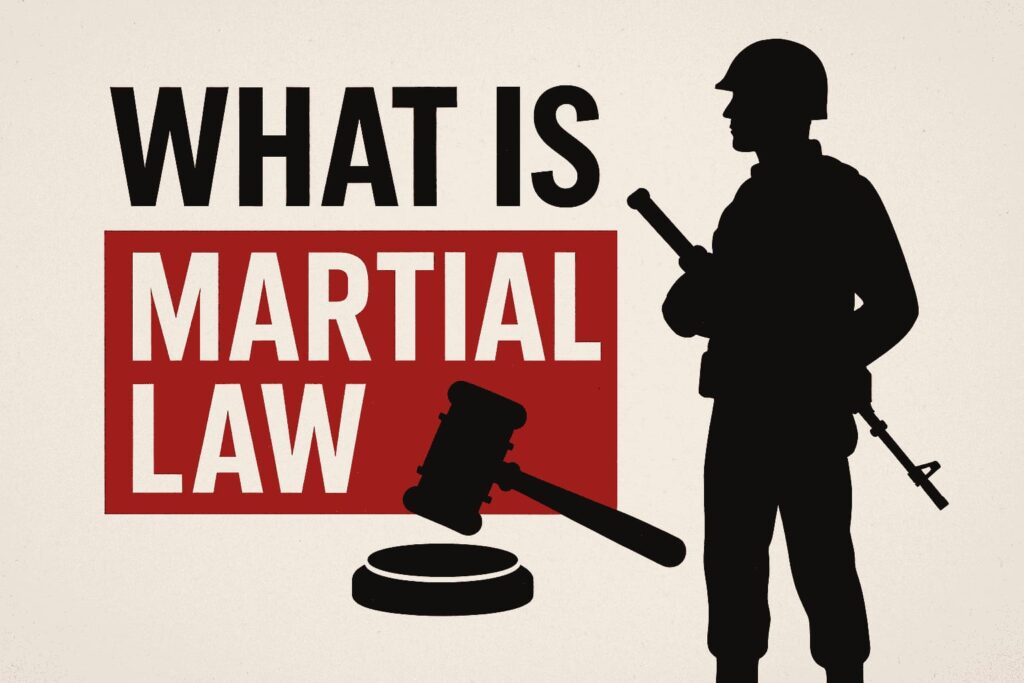Martial law is a temporary shift of power from civilian authorities to the military during a severe crisis. Governments reach for it when ordinary policing and administration stop working—because of war, invasion, insurrection, or a collapse of order after a major disaster. It is meant to be exceptional and short-lived. When declared, military orders can override some civilian rules in a defined place for a defined time, with the stated goal of restoring normal government.
How martial law is different from a “state of emergency”
People often mix these up. A state of emergency keeps civilian government in charge but unlocks extra powers written into law—curfews, requisitioning supplies, fast-tracking funds. Martial law goes further: it places part or all of civilian authority under military control. In practice, many countries try to operate inside emergency powers first and only consider martial law if civilian institutions can’t function at all. That distinction matters because democratic systems are built on civilian supremacy. Crossing into martial law is supposed to be a last resort, not an alternative style of governing.
Who can declare it, where does it apply, and for how long?
The answer depends on the country’s constitution and statutes. Some systems let a president or prime minister declare martial law; others require a vote in parliament or immediate legislative review. Declarations can be national but are often limited to the province or city where the breakdown is happening. Duration should be spelled out in the proclamation and tied to the specific emergency. Good practice requires periodic review, transparent reporting, and a clear legal test for when conditions no longer justify the measure. The longer martial law runs, the higher the risk of rights violations and political abuse, which is why most modern constitutions try to narrow both scope and time.
What actually changes on the ground
Life under martial law feels different because everyday interactions are mediated by soldiers and military orders. Curfews and checkpoints become routine. Movement can be restricted between neighborhoods or districts. Permits may be needed for gatherings, marches, or even travel at certain hours. Searches happen with fewer procedural steps than normal. Local civilian agencies—the police, transport authorities, sometimes even utilities—can be placed under military command so decisions are fast and coordinated.
Courts ideally keep operating, because access to independent judges is one of the best safeguards against abuse. If courts are closed or can’t function safely, some jurisdictions allow temporary military tribunals, but only for as long as civilian courts truly cannot work. That boundary is crucial. Where ordinary courts remain open, trying civilians in military courts has historically been struck down as unlawful in democratic systems.
Modern declarations also reach into the digital sphere. Governments may order internet shutdowns or throttle mobile data to slow rumors and organizers, restrict social media, or require platforms to remove content that could inflame violence. Supporters see this as preventing panic; critics see it as a fast track to censorship and unaccountable power. Either way, digital controls are now a predictable feature of crisis governance.
The legal logic: necessity and proportionality
Two ideas anchor any lawful use of martial law.
Necessity asks whether civilian authorities are genuinely unable to maintain order. If less extreme tools—mutual-aid policing, emergency statutes, targeted deployments—can do the job, martial law is not justified.
Proportionality asks whether the measures fit the danger. Restrictions should be no broader and no longer than needed to restore civil authority. That includes geography (only the affected region), time (automatic expiration or frequent review), and substance (only the powers that are strictly required).
A third idea—civilian supremacy—says that even when the military is temporarily in charge, it remains answerable to elected authorities and ultimately to the law. Independent courts should be able to review detentions, censorship orders, and the continued need for the proclamation.
What martial law does not do
It does not automatically suspend a constitution. Certain rights may be limited for safety—movement, assembly, late-night business hours—but fundamental protections still exist. Detentions should be reviewable. Property seizures must be tied to the emergency and compensated where the law requires. Elections are not automatically cancelled; if they must be postponed for practical reasons, there should be a clear legal basis, a new date, and oversight from courts or election bodies.
Country snapshots (what history teaches)
In the United States, courts shaped the modern limits after the Civil War. The Supreme Court held that civilians cannot be tried by military tribunals when ordinary courts are open and functioning. During World War II, Hawaii was placed under martial law after the Pearl Harbor attack. The wartime emergency was real, but later cases criticized the continued use of military courts once civilian courts could operate, reinforcing the principle that necessity must drive the scope and timing.
The Philippines offers a different lesson. Martial law declared in 1972 was justified by insurgency and disorder. It centralized power for years, curbed dissent, and restructured political life far beyond the initial emergency. Even after the formal end of martial law, the political and social effects lingered. This illustrates how extended declarations can outgrow their original rationale and reshape institutions.
Thailand has used martial law during several coups and periods of instability. In those cycles, martial law became both a tool to control unrest and a bridge to military-backed rule, showing how hard it is to return power to civilians when the armed forces dominate the transition. The pattern across these examples is consistent: the more narrowly defined the powers and the clearer the exit ramp, the healthier the return to normal governance.
Human rights and international law
Most countries have signed human-rights treaties that allow limited, temporary derogations—lawful departures from some obligations—during public emergencies that “threaten the life of the nation.” Even then, certain rights cannot be suspended: the right to life, freedom from torture, and recognition before the law are non-derogable. States must publicly declare what rights they are limiting and why, report those limits internationally, and end them as soon as conditions allow. In practice, courts and rights commissions look hard at whether limits are targeted, time-bound, and monitored.
Oversight that actually works
Written rules matter, but enforcement is what keeps extraordinary powers from becoming the new normal. Strong oversight usually mixes several elements:
- Judicial review so detentions and restrictions can be challenged quickly.
- Legislative supervision through regular briefings, renewal votes, and budget control.
- Independent media and civil society to document what happens on the ground.
- Transparency about specific orders, not just vague appeals to “security.”
When these pieces are in place, abuses are fewer, cooperation from the public is higher, and the return to ordinary law happens faster.
Typical questions people ask
Can the military patrol streets? Yes, that’s the point—visible presence and rapid response. But soldiers still owe duties to the law and can be held accountable for misconduct.
Can businesses be forced to close? Yes, if tied to the emergency. Orders usually focus on hours, crowding, and locations that are flashpoints for unrest.
What happens to protests? Assemblies may be limited or require permits during the emergency. Peaceful expression is still protected in principle, but courts will weigh it against immediate safety concerns.
How is it lifted? The same authority that declared it issues a termination or lets it lapse. Ideally, the proclamation itself has a sunset clause and a checklist: courts open and functioning, police able to maintain order, essential services stable, and credible risk reduced.
The digital-age twist
Crisis management now plays out on smartphones. Rumor cascades can move faster than official corrections. Governments may respond with platform takedowns, mass SMS alerts, “information operations,” and sometimes full shutdowns. Blunt tactics can backfire, harming businesses, hospitals, and disaster response. Smarter approaches emphasize verified public updates, targeted content moderation with clear legal bases, and rapid judicial remedies when expression is wrongly limited. The principle doesn’t change: powers must be necessary, proportionate, and reviewable.
Bottom line
Martial law is not a routine policy choice; it is an emergency bridge to get from breakdown to a working civil order. Used narrowly—limited area, limited time, clear legal basis, active oversight—it can stabilize a crisis. Used broadly or indefinitely, it risks eroding rights, weakening institutions, and normalizing military dominance over civilian life. The most reliable safeguard is the exit ramp: from the first day of a declaration, officials should be able to explain exactly what conditions must be met to end it and how the country will return to ordinary constitutional rule.
Sources for further reading
- Encyclopaedia Britannica, “Martial law.”
- Congressional Research Service, reports on martial law and emergency powers in the United States.
- Library of Congress — Duncan v. Kahanamoku, 327 U.S. 304 (1946)
Also read:


